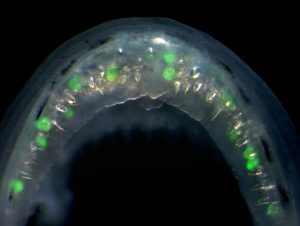My colleague calls them “Frankenfish.” Assistant Professor Tyler Square calls them mutant lines in model teleost species. The Department of Microbiology and Cell Science recently hired a developmental biologist, and his research is fascinating.

Assistant Professor Square comes to UF from The University of California Berkeley, where he was a postdoc in the lab of Associate Professor Craig Miller. The Square lab largely focuses on the genetics of skeletal formation. He uses model fish species—sticklebacks (Gasterosteus aculeatus) and zebrafish (Danio rerio)—to identify the signaling pathways and transcription factors that drive tooth generation and replacement. “At UF, I will continue two main research directions: 1) uncovering genetic similarities between teeth and other epithelial organs like hair and scales, and 2) determining how cellular inputs and genetic interactions can be modified or controlled to drive tooth and bone growth,” explains Square. His current research aims to understand the signaling pathways that control tooth specification, maintenance, and regeneration.
Organ Replacement?
It may sound alarming at first, but vertebrate bodies regularly undergo whole-organ replacement. This startling fact becomes less disconcerting when you learn that these organs refer to those associated with the epithelium like teeth, hair, scales, and feathers. Tooth replacement is a common feature across vertebrates even though arrangement, shape, size, placement, and the regeneration system they employ vary widely across species. The fact that humans (generally speaking) go through one tooth regeneration cycle in predefined tooth positions, whereas sharks have dentition that regenerates throughout their lives is a prime example of this. The balance between conservation and diversity in tooth development begs the question—what genetic signatures are common to the evolution of teeth and tooth-like structures (odontodes)?
Square’s most recent paper, Modulation of tooth regeneration through opposing responses to Wnt and BMP signals in teleosts, revealed that the signaling pathways for tooth generation include the same genes that signal hair regeneration in mammals. This was determined through the overexpression of hair-regeneration gene orthologs in the fish models mentioned above. Despite exhibiting different tooth regeneration strategies, manipulation of these genes of interest resulted in the increase and/or decrease of tooth replacement cycles in both fish species. Also, the fish homolog of one key signal (Bmp6) known to be a master regulator of hair follicle stem cells was found to activate a genetic response in dental tissue that mimicked what is known in hair regeneration. This discovery suggests that epithelial appendages such as hair, scales, feathers, and teeth may share a common genetic network and evolutionary history.
Forming New Teeth
“I am particularly excited to start making new mutant fish lines that will answer important questions about how tooth induction signals are communicated between cells. This goes for both the cells that normally become teeth as well as cells that can be ‘convinced’ to switch to a dental fate,” continues Square. Teeth grow in specific locations in the body due to signaling interactions between multiple cell types. Understanding the genetic response mechanisms of these important signaling events may allow us in the future to regrow teeth that have been lost in adult humans.
 Want to change the future of developmental biology research?
Want to change the future of developmental biology research?
The Square lab will be accepting doctoral students interested in advancing the field of developmental genetics and the evolution of skeletal formation.
Want to learn more?
Associate Professor Square also offers an upper-division course through the University of Florida’s Department of Microbiology and Cell Science: PCB 4522 – Molecular Genetics
About UF Microbiology and Cell Science: The Department of Microbiology and Cell Science at the University of Florida is the largest microbiology program in the United States with an enrollment of approximately 1000 undergraduate majors, 700 graduate students, and over 50 doctoral students. Faculty research programs span areas of broad interest in the cellular and molecular aspects of bacterial, plant, and animal life functions.
 2
2
 Want to change the future of developmental biology research?
Want to change the future of developmental biology research?